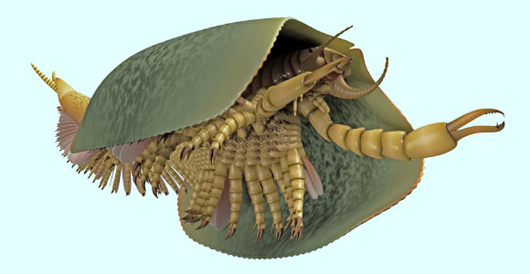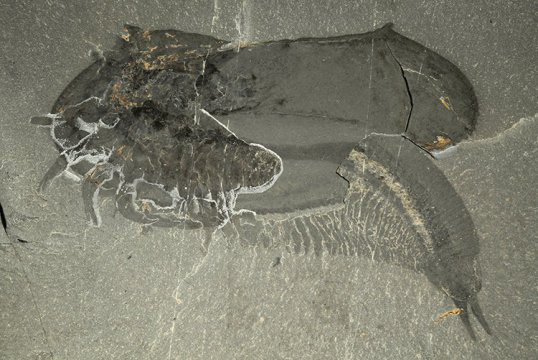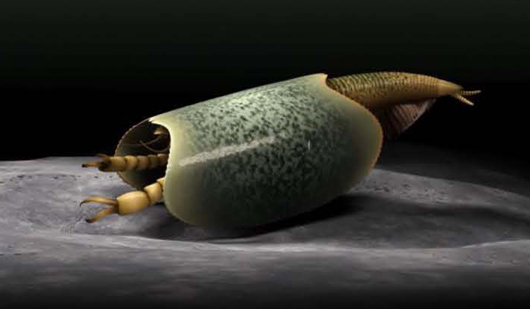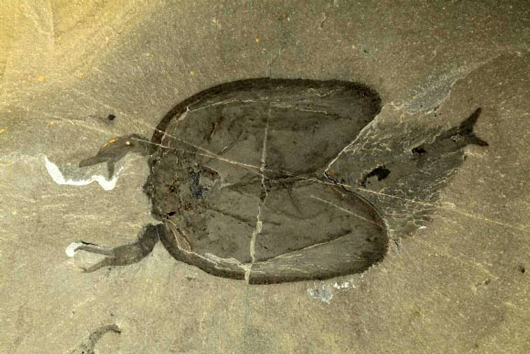Remarkable Fossil with “Can-opener” Claws – Tokummia katalepsis
The Origins of the Mandibulate Body Plan
Scientists at the University of Toronto in collaboration with colleagues at the Royal Ontario Museum, have published this week a scientific paper describing Tokummia katalepsis, a predator from the Cambrian, one that has provided palaeontologists with a better understanding of the evolution of one of the most numerous and diverse group of animals on Earth.
Tokummia katalepsis
The fossils, collected during extensive field work exploring 508-million-year-old sedimentary rocks near Marble Canyon in Kootenay National Park, (British Columbia), shed light on the origin of a group of arthropods collectively known as the Mandibulata. The Mandibulata is a clade of the phylum Arthropoda that consists of millipedes, centipedes, the crustacea and insects. Mandibulates are united by having a pair of specialised jaws “mandibles”, which can be used for a variety of purposes such as hunting, biting, cutting food into smaller pieces, digging, carrying items and constructing nests.
A Computer-Generated Image of Tokummia katalepsis

A three-dimensional computer generated image of Tokummia katalepsis showing serrated pincers and the pair of mandibles.
Picture credit: Royal Ontario Museum
Studying the Arthropoda
The mandibulates constitute the largest, most speciose and most varied clade within the Arthropoda, but their evolutionary origins are poorly understood. The discovery of several well-preserved specimens of T. katalepsis documents, for the first time, the anatomy of an early member of the Mandibulata.
Commenting on the significance of this research, Cédric Aria (University of Toronto) and lead author of the paper published in the journal “Nature” stated:
“In spite of their colossal diversity today, the origin of mandibulates had largely remained a mystery. Before now we’ve had only sparse hints at what the first arthropods with mandibles could have looked like and no idea of what could have been other key characteristics that triggered the unrivalled diversification of that group.”
One of the T. katalepsis Fossils Used in the Study

The flattened fossil of Tokummia showing numerous legs, the dorsal carapace and the specialised pincers.
Picture credit: Jean-Bernard Caron (Royal Ontario Museum)
The photograph above shows one of the beautifully preserved fossils found in 2014. This specimen of Tokummia katalepsis shows a number of strong legs on the left partially protruding from the body, the shape of the bivalved carapace and dozens of small paddle-like limbs below the trunk at the lower right.
A Cross Between a Crab, a Centipede and a Can-opener
Described by some observers as looking like a cross between a crab, a centipede and a can-opener, Tokummia lived in a tropical sea that teemed with early marine life-forms including the ancestors of vertebrates. At around ten centimetres in length, T. katalepsis was one of the largest predators in the ecosystem. It had large pincers which the researchers thought would have been too delicate to tackle shelled animals like brachiopods and bivalves.
The research team postulate that Tokummia was primarily benthic (living on the sea floor), where it scuttled about digging into the sediment to catch soft bodied creatures such as worms. The claws reminded the scientists of a can-opener, once grasped, any unfortunate prey would have been cut up into more easily digestible pieces by those revolutionary, broad, serrated mandibles.
The genus name honours Tokumm Creek, a small river that runs through Marble Canyon, the location of the fossil finds. The species or trivial name is derived from the ancient Greek for “grasping”.
A Computer-Generated Image from a Video that Demonstrates Tokummia Locomotion
Picture credit: Royal Ontario Museum
Co-author of the scientific paper and an expert on the Burgess Shale biota, Jean-Bernard Caron (Royal Ontario Museum and an Associate Professor at the University of Toronto), stated:
“This spectacular new predator, one of the largest and best preserved soft-bodied arthropods from Marble Canyon, joins the ranks of the many unusual marine creatures that lived during the Cambrian Explosion, a period of rapid evolutionary charge starting about half a billion years ago when most major animal groups first emerged in the fossil record.”
Numerous Fossil Specimens Studied
Careful mechanical preparation of the numerous specimens coupled with photographic work carried out under differing wavelengths of light, revealed the details of the Tokummia body plan. The segmented trunk of Tokummia consisted of fifty small segments covered by a wide, two-piece carapace. The delicate fossils show evidence of the pair of broad, notched mandibles as well as the large but quite delicate-looking front claws (maxillipeds), which are typical features of extant mandibulates.
Importantly, the animal bears subdivided limb bases with tiny projections called endites, which can be found in the larvae of certain crustaceans alive today and are now thought to have been critical innovations for the evolution of the various legs of mandibulates, and even for the mandibles themselves.
Fossils Providing an Insight into the Evolution of the Mandibulata
Picture credit: Royal Ontario Museum
Tokummia katalepsis Similar to Living Members of the Myriapoda
Graduate student Cédric Aria added that the many segments that make up the body are very reminiscent of living Myriapoda, the sub-phylum of Arthropoda that includes centipedes, millipedes and their relatives.
He went onto state:
“Tokummia also lacks the typical second antenna found in crustaceans, which illustrates a very surprising convergence with such terrestrial mandibulates.”
The study also resolves the affinities of other emblematic fossils excavated from Canada’s famous Burgess Shale deposits, more than a hundred years after their initial discovery. Burgess Shale fossils such as Branchiocaris, Canadaspis and Odaraia form with Tokummia, a group of crustacean-like arthropods that can now be placed at the base of all mandibulates, they can be regarded as basal members of the Mandibulata.
The scientific paper: “Burgess Shale Fossils Illustrate the Origin of the Mandibulate Body Plan”: by Cédric Aria and Jean-Bernard Caron, published in the journal “Nature”.
Visit Everything Dinosaur’s website: Everything Dinosaur.



